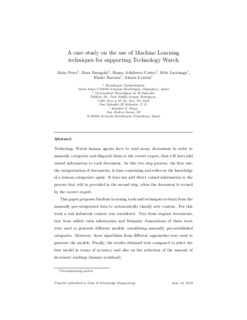
Título
A case study on the use of machine learning techniques for supporting technology watchOtras instituciones
Koniker S. KoopUniversidad Tecnológica de El Salvador (UTEC)
Versión
Preprint en revisión
Derechos
© 2018 Elsevier B.V. All rights reserved.Acceso
Acceso abiertoVersión del editor
https://doi.org/10.1016/j.datak.2018.08.001Publicado en
Data and Knowledge Engineering Vol. 117. Pp. 239-251. September, 2018Primera página
239Última página
251Editor
ElsevierPalabras clave
Text mining
Knowledge management applications
Multi-classification
Technology watch automation ... [+]
Knowledge management applications
Multi-classification
Technology watch automation ... [+]
Text mining
Knowledge management applications
Multi-classification
Technology watch automation
Semantic annotations [-]
Knowledge management applications
Multi-classification
Technology watch automation
Semantic annotations [-]
Resumen
Technology Watch human agents have to read many documents in order to manually categorize and dispatch them to the correct expert, that will later add valued information to each document. In this two ... [+]
Technology Watch human agents have to read many documents in order to manually categorize and dispatch them to the correct expert, that will later add valued information to each document. In this two step process, the first one, the categorization of documents, is time consuming and relies on the knowledge of a human categorizer agent. It does not add direct valued information to the process that will be provided in the second step, when the document is revised by the correct expert.
This paper proposes Machine Learning tools and techniques to learn from the manually pre-categorized data to automatically classify new content. For this work a real industrial context was considered. Text from original documents, text from added value information and Semantic Annotations of those texts were used to generate different models, considering manually pre-established categories. Moreover, three algorithms from different approaches were used to generate the models. Finally, the results obtained were compared to select the best model in terms of accuracy and also on the reduction of the amount of document readings (human workload). [-]
Sponsorship
KonikerColecciones
- Artículos - Ingeniería [743]




















